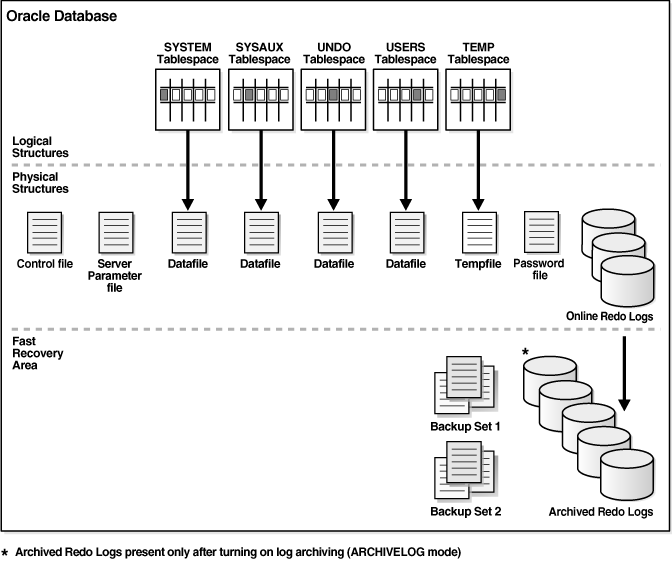About Database Storage Structures
An Oracle database is made up of physical and logical structures. Physical structures can be seen and operated on from the operating system, such as the physical files that store data on a disk.
Logical structures are created and recognized by Oracle Database and are not known to the operating system. The primary logical structure in a database, a tablespace, contains physical files. The applications developer or user may be aware of the logical structure, but is not usually aware of this physical structure. The database administrator (DBA) must understand the relationship between the physical and logical structures of a database.
Figure 6-1 shows the relationships between logical and physical structures. This figure also shows recovery-related structures that are optionally kept in the fast recovery area. See "Fast Recovery Area" for more information.
Figure 6-1 Oracle Database Storage Structures

Description of "Figure 6-1 Oracle Database Storage Structures"
Oracle Database can automate much of the management of its structure. Oracle Enterprise Manager Database Express (EM Express) provides a Web-based graphical user interface (GUI) to enable easier management and monitoring of your database.
From a physical perspective, a multitenant container database (CDB) has basically the same structure as a non-CDB, except that each pluggable database (PDB) has its own set of tablespaces (including its own SYSTEM and SYSAUX tablespaces) and data files.
A CDB contains the following files:
-
One control file
-
One online redo log
-
One or more sets of temp files
-
One set of undo data files
-
A set of system data files for every container
-
Zero or more sets of user-created data files
This section provides background information about the various database storage structures. It contains the following topics:
See Also:
-
Oracle Database Concepts for more information about database storage structures
-
Oracle Database Concepts for an introduction to CDBs and PDBs
-
Oracle Database Concepts for more information about database files in a CDB